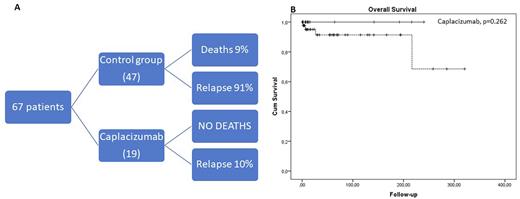Abstract
Background Caplacizumab is the first targeted therapy, approved for acquired thrombotic thrombocytopenic purpura (aTTP). Our multicenter real-world study was designed to assess real-world outcomes of caplacizumab compared to historic controls, emphasizing on re-administration of caplacizumab and plasma-exchange free treatment.
Methods: We recorded clinico-biological data from adult patients treated for aTTP over the last decade (2011-2021) according to current treatment guidelines. Diagnosis was confirmed with ADAMTS13 activity. Results are presented as median, range.
Results: We have studied 66 patients (age 47 years, 19-75): 19 in the caplacizumab and 47 in the historic control group (Figure A). Patients that received caplacizumab had lower hemoglobin levels at diagnosis (p=0.029), higher rate of underlying comorbidities (p=0.005), but lower rate of neurological involvement (p=0.001). No other significant differences were observed in patient or disease characteristics between groups.
Caplacizumab was given at a median on day 5 (1-32) from diagnosis (10 mg daily) for 30 (6-40) doses. In four patients, caplacizumab was administered after refractoriness to plasma exchange. In two patients, aTTP occurred early after COVID-19 infection. There were no major hemorrhagic events or other grade 3 complications. Median plasma exchange sessions were 12 (8-23) in caplacizumab group, versus 14 (6-32) in the control group. Early platelet normalization was achieved in all patients, following 5 (3-7) days from caplacizumab administration. ADAMTS13 activity normalized at the end of treatment in all caplacizumab-treated patients (25-52%). Two relapses have been observed within 13 and 18 months of the first caplacizumab administration, with low ADAMTS13 levels (<1%). In the first patient, caplacizumab was re-administered at regular dosing from day 1 of relapse, together with steroids but without plasma exchange. In the second patient, caplacizumab was started 10 days after initial relapse, because of poor response to plasma exchange and steroids. A rapid normalization of platelet count was observed in both patients within 10 and 4 days respectively, from the start of caplacizumab.
Control patients presented 1 (0-14) relapse. After a median of 19.0 (2.6-320) months from aTTP diagnosis, there were 4 deaths (only from the control group, p-0.262, Figure B).
Conclusion: Our real-world multicenter study provides updated data showing that caplacizumab is safe and effective in aTTP, even in patients refractory to plasma exchange, after re-administration, and in patients, who have not received plasma exchange treatment. Further studies in large real-world populations with longer follow-up are needed to delineate the algorithm of aTTP treatment in the era of personalized medicine.
Disclosures
Gavriilaki:Alexion: Honoraria; Omeros: Honoraria; Sanofi: Honoraria; Jazz: Research Funding; Gilead: Honoraria.
Author notes
Asterisk with author names denotes non-ASH members.


